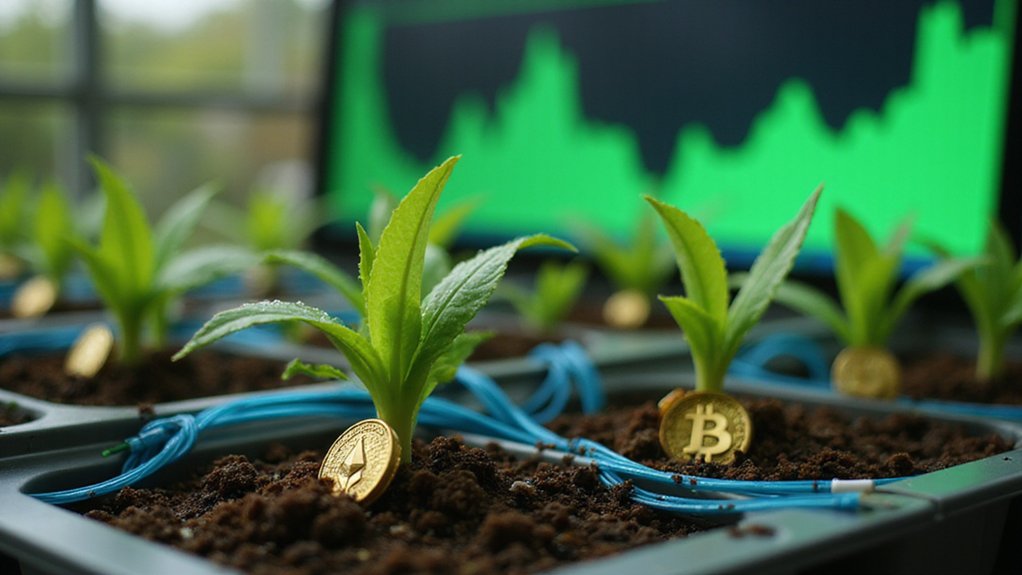Yield farming—crypto’s agricultural frontier—involves strategically deploying digital assets across DeFi protocols to harvest impressive returns. Participants deposit tokens into liquidity pools, earning governance tokens measured as APY while simultaneously supporting decentralized exchanges. Unlike traditional banking’s passive approach, this cultivation requires active management and entails substantial risks: impermanent loss, smart contract vulnerabilities, market volatility, and regulatory uncertainty. The prospective farmer must weigh potentially astronomical yields against these considerable hazards before sowing their first digital seeds.

How did the agricultural metaphor of “farming” become inextricably linked with one of cryptocurrency’s most sophisticated financial mechanisms? Perhaps it’s the notion of cultivating returns from digital assets that otherwise sit dormant in wallets—a peculiar evolution of financial vocabulary that belies the complexity beneath.
Yield farming, at its core, represents a method whereby cryptocurrency holders deploy their digital assets across various DeFi platforms to generate returns.
Cryptocurrency’s answer to financial cultivation—assets sown across DeFi protocols, harvested as yields previously unimaginable in traditional banking ecosystems.
Unlike traditional finance‘s predictable interest-bearing accounts, yield farming demands an active approach—users strategically relocate tokens between protocols in pursuit of maximum yields, a practice requiring vigilance and technical acumen that would make traditional bankers blanch.
The mechanics involve depositing tokens into liquidity pools or specialized yield farming contracts, where they serve dual purposes: providing essential liquidity to decentralized exchanges while simultaneously earning rewards, typically distributed in governance tokens. These rewards are generally measured as annual percentage yield and accrue to farmers in real-time.
These tokens—often with inscrutable names and logos¹—carry their own value proposition, representing voting rights within the protocol’s ecosystem while functioning as tradable assets.
This pursuit of maximized returns isn’t without considerable hazards.
Impermanent loss—that counterintuitive phenomenon where providing liquidity results in fewer assets than simply holding—remains an ever-present threat.
Smart contract vulnerabilities introduce additional perils; code is law until it isn’t.
Market volatility compounds these risks, with potential regulatory incursions hovering perpetually on the horizon.
Compared to staking—its more conservative crypto cousin—yield farming presents a dichotomy of risk and reward.
While staking offers predictable returns through passive token locking, yield farming’s dynamic token movement across platforms creates potential for substantially higher yields (though such returns occasionally strain credulity). Unlike yield farming, staking involves participating in a proof-of-stake consensus where validators secure the network by locking their tokens.
The process requires meticulous preparation: establishing compatible wallets, acquiring appropriate tokens, selecting reputable platforms, depositing assets strategically, and constantly monitoring performance.
For the dedicated practitioner willing to navigate its complexities, yield farming represents DeFi’s quintessential risk-reward proposition—a financial frontier where traditional banking’s cautious certainty gives way to algorithmic opportunity.
Many farmers utilize aggregator platforms like Yearn Finance and Harvest Finance that automatically shift funds between protocols to optimize returns without constant manual intervention.
¹Consider the menagerie of food-themed tokens that dominated early yield farming.
Frequently Asked Questions
How Do Taxes Work on Yield Farming Profits?
Yield farming profits navigate a bifurcated tax landscape that would make even seasoned CPAs wince.
Rewards received constitute ordinary income—taxable at their fair market value upon receipt—while subsequent sales of these tokens trigger capital gains considerations.
The unfortunate farmer must meticulously track each transaction (a Herculean task given DeFi’s complexity) or risk tax compliance nightmares.
Long-term holds may qualify for preferential rates, though the perpetual churn of yield optimization rarely accommodates such patient strategies.
What Security Measures Protect Against Yield Farming Smart Contract Exploits?
Security measures protecting yield farming from smart contract exploits include rigorous code audits, formal verification processes, and thorough testing protocols.
Many platforms implement timelocks, multi-signature requirements, and circuit breakers that halt operations when suspicious activity occurs.
Insurance protocols offer coverage against technical failures, while bug bounty programs incentivize white-hat hackers to disclose vulnerabilities.
The immutable nature of blockchain—both blessing and curse—necessitates meticulous pre-deployment scrutiny, as post-launch fixes often prove challenging.
Can Yield Farming Strategies Work in Bear Markets?
Yield farming can indeed function during bear markets, albeit with adjusted expectations and strategies.
Savvy farmers pivot toward stablecoin pools (which, remarkably, often see increased TVL during downturns) and leverage-based approaches that capitalize on downward price action.
The risk-reward calculus shifts dramatically, however—impermanent loss becomes particularly pernicious, and the already-thin margins grow thinner still.
Diversification across multiple protocols and constant vigilance become not merely advisable but essential for those intrepid enough to farm amid falling markets.
How Do Impermanent Loss Calculators Help Yield Farmers?
Impermanent loss calculators serve as essential risk management tools for yield farmers traversing DeFi’s mathematical labyrinth.
These instruments transform complex variables—asset weightings, price volatility, and time horizons—into digestible projections, allowing farmers to quantify potential losses before they materialize.
By comparing expected IL against projected yields, practitioners can determine whether a pool’s rewards justify its risks (a calculation surprisingly few perform before depositing six-figure sums into untested protocols).
Some even simulate multiple price scenarios, offering strategic foresight in volatile markets.
Which Wallets Offer the Best Yield Farming Tracking Features?
MetaMask and Trust Wallet lead the pack with robust yield farming tracking capabilities, offering real-time portfolio monitoring across multiple chains.
Zerion and Zapper distinguish themselves with detailed dashboards that visualize APYs and impermanent loss metrics—quite useful for those who prefer analytics without spreadsheet gymnastics.
DeFi Saver excels with automation tools, while hardware options like Ledger, when paired with portfolio trackers, provide the security-conscious farmer both protection and visibility into their burgeoning digital harvests.









